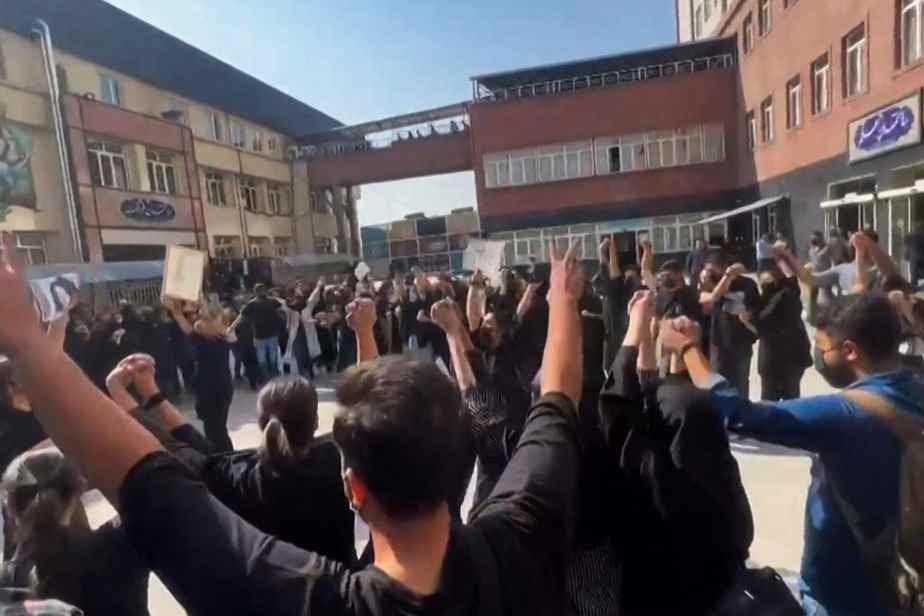(Paris) Iranians again took to the streets on Saturday to demonstrate against power, a month after the start of the protest movement sparked by the death of Mahsa Amini and repressed in blood, according to media and NGOs.
Posted at 8:21 a.m.
Updated at 10:32 a.m.
The 22-year-old Iranian Kurd died on September 16, three days after her arrest by vice police in Tehran, for allegedly violating the Islamic Republic’s strict dress code, including the wearing of the veil for the women.
The Iranian authorities claim that the young woman died of an illness and not of “beatings”, according to a medical report rejected by her father. According to her cousin, she died after “a violent blow to the head”.
Since then, scores of young women have spearheaded protests, shouting anti-government slogans, stripping and burning their headscarves, and standing up to security forces in the streets.

PHOTO MUNIR UZ ZAMAN, AGENCE FRANCE-PRESSE
A demonstration in support of the Iranians took place in Dhaka, Bangladesh on Saturday.
“The mullahs must get out! chanted hijabless women at the Shariati Technical and Vocational College in Tehran on Saturday, in a video widely shared online.
In western Tehran, protesters threw projectiles at security forces near a major roundabout in the city of Hamedan, according to footage verified by AFP.
Despite severe internet disruptions and authorities blocking Instagram and WhatsApp, Iranians gathered in the streets of Ardabil in the northwest of the country on Saturday, according to videos shared on Twitter.
Shopkeepers went on strike in Saghez, the hometown of Mahsa Amini in the province of Kurdistan (north-west), and in Mahabad (north), according to the online media 1500tasvir, which lists human rights violations .

VIDEO SCREEN CAPTURE UGC/AGENCE FRANCE-PRESSE
Students from Isfahan University organized a sit in Saturday.
“Schoolgirls in the village of Ney in Marivan (west) started street fires and shouted anti-government chants,” said Hengaw, a Norwegian-based Iranian Kurdish rights group.
Young people also demonstrated at universities in Tehran, Isfahan (south) and Kermanshah (northwest), according to images shared online.
“Sensitive situation”
The demonstrators were responding to a call from activists for massive protests under the slogan “The beginning of the end! ” power.
These activists have encouraged Iranians to demonstrate in places where security forces are not present and to chant “Death to the dictator”, in reference to Supreme Leader Ali Khamenei.
Faced with these demonstrations, the Islamic Development Coordination Council, an official body, called on Iranians to say in mosques, after evening prayers on Saturday, “their anger against the rioters and the sedition”.
“Retirees” of the Revolutionary Guards, the ideological army of the Islamic Republic, also gathered on Saturday, according to the reformist newspaper Shargh.
At the rally, a Guardians commander said three members of his paramilitary Basij militia had been killed and 850 injured in Tehran since the start of the “sedition”, the official Irna news agency reported.
The protest, which has entered its fifth week, has sparked solidarity rallies abroad and the crackdown, which has claimed more than 100 lives according to NGOs, has been condemned by the international community.
At least 108 people have been killed in the crackdown, according to the Oslo-based NGO Iran Human Rights (IHR). Amnesty International claimed that at least 23 children between the ages of 11 and 17 had been “killed by security forces”. And hundreds of people were arrested.
“Brave Women”
On Friday, US President Joe Biden, whose country is a sworn enemy of Iran, said he stood “alongside the brave women of Iran”, calling on the government to “end violence against its citizens”.
Iranian leaders accuse the United States of destabilizing their country by fomenting “riots”.
As the European Union prepares to impose sanctions on Iran on Monday, Iranian Foreign Minister Hossein Amir-Abdollahian called on the EU to adopt a “realistic approach”.
He also castigated a policy of double standards on Friday: “Who would have thought that the death of a single girl would be so important for Westerners? What have they done about the hundreds of thousands of martyrs and deaths in Iraq, Afghanistan, Syria and Lebanon? “.
The protests in Iran are the largest since those in 2019 against rising gasoline prices in the oil-rich country.
